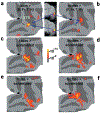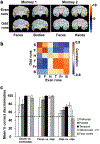Faces and objects in macaque cerebral cortex
- PMID: 12925854
- PMCID: PMC8117179
- DOI: 10.1038/nn1111
Faces and objects in macaque cerebral cortex
Abstract
How are different object categories organized by the visual system? Current evidence indicates that monkeys and humans process object categories in fundamentally different ways. Functional magnetic resonance imaging (fMRI) studies suggest that humans have a ventral temporal face area, but such evidence is lacking in macaques. Instead, face-responsive neurons in macaques seem to be scattered throughout temporal cortex, with some relative concentration in the superior temporal sulcus (STS). Here, using fMRI in alert fixating macaque monkeys and humans, we found that macaques do have discrete face-selective patches, similar in relative size and number to face patches in humans. The face patches were embedded within a large swath of object-selective cortex extending from V4 to rostral TE. This large region responded better to pictures of intact objects compared to scrambled objects, with different object categories eliciting different patterns of activity, as in the human. Overall, our results suggest that humans and macaques share a similar brain architecture for visual object processing.
Conflict of interest statement
Competing Interests Statement
The authors declare that they have no competing financial interests.
Figures




Similar articles
-
Neural representations of faces and body parts in macaque and human cortex: a comparative FMRI study.J Neurophysiol. 2009 May;101(5):2581-600. doi: 10.1152/jn.91198.2008. Epub 2009 Feb 18. J Neurophysiol. 2009. PMID: 19225169 Free PMC article.
-
Color-Biased Regions of the Ventral Visual Pathway Lie between Face- and Place-Selective Regions in Humans, as in Macaques.J Neurosci. 2016 Feb 3;36(5):1682-97. doi: 10.1523/JNEUROSCI.3164-15.2016. J Neurosci. 2016. PMID: 26843649 Free PMC article.
-
The effect of face patch microstimulation on perception of faces and objects.Nat Neurosci. 2017 May;20(5):743-752. doi: 10.1038/nn.4527. Epub 2017 Mar 13. Nat Neurosci. 2017. PMID: 28288127 Free PMC article.
-
[Hierarchical functional organization and face representation in inferotemporal cortex of monkeys].Brain Nerve. 2012 Jul;64(7):831-9. Brain Nerve. 2012. PMID: 22764355 Review. Japanese.
-
More Than the Face: Representations of Bodies in the Inferior Temporal Cortex.Annu Rev Vis Sci. 2022 Sep 15;8:383-405. doi: 10.1146/annurev-vision-100720-113429. Epub 2022 May 24. Annu Rev Vis Sci. 2022. PMID: 35610000 Review.
Cited by
-
Faces in motion: selectivity of macaque and human face processing areas for dynamic stimuli.J Neurosci. 2013 Jul 17;33(29):11768-73. doi: 10.1523/JNEUROSCI.5402-11.2013. J Neurosci. 2013. PMID: 23864665 Free PMC article.
-
Single-unit recordings in the macaque face patch system reveal limitations of fMRI MVPA.J Neurosci. 2015 Feb 11;35(6):2791-802. doi: 10.1523/JNEUROSCI.4037-14.2015. J Neurosci. 2015. PMID: 25673866 Free PMC article.
-
Beta modulation reflects name retrieval in the human anterior temporal lobe: an intracranial recording study.J Neurophysiol. 2016 Jun 1;115(6):3052-61. doi: 10.1152/jn.00012.2016. Epub 2016 Apr 13. J Neurophysiol. 2016. PMID: 27075536 Free PMC article.
-
Color architecture in alert macaque cortex revealed by FMRI.Cereb Cortex. 2006 Nov;16(11):1604-13. doi: 10.1093/cercor/bhj099. Epub 2005 Dec 28. Cereb Cortex. 2006. PMID: 16400160 Free PMC article.
-
Parallel, multi-stage processing of colors, faces and shapes in macaque inferior temporal cortex.Nat Neurosci. 2013 Dec;16(12):1870-8. doi: 10.1038/nn.3555. Epub 2013 Oct 20. Nat Neurosci. 2013. PMID: 24141314 Free PMC article.
References
-
- Ungerleider L & Mishkin M Two cortical visual systems. in Analysis of Visual Behavior (ed. Ingle D) 549–586 (MIT Press, Cambridge, Massachusetts, 1982).
-
- Logothetis N & Sheinberg D Visual object recognition. Annu. Rev. Neurosci 19, 577–621 (1996). - PubMed
-
- Gross CG, Rocha-Miranda CE & Bender DB Visual properties of neurons in inferotemporal cortex of the macaque. J. Neurophysiol 35, 96–111 (1972). - PubMed
-
- Perrett D, Hietanen J, Oram M & Benson P Organization and function of cells responsive to faces in the temporal cortex. Phil. Trans. R. Soc. Lond 335, 23–30 (1992). - PubMed
Publication types
MeSH terms
Grants and funding
LinkOut - more resources
Full Text Sources

